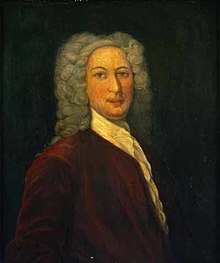Philip Livingston (1686-1749)
| Philip Livingston | |
|---|---|
 |
|
| 2nd Lord of Livingston Manor | |
|
In office 1728 – 1749 |
|
| Preceded by | Robert Livingston the Elder |
| Succeeded by | Robert Livingston |
| Personal details | |
| Born |
July 9, 1686 Albany, New York |
| Died | February 11, 1749 (aged 62) New York, British America |
| Nationality | American |
| Spouse(s) | Catherine Van Brugh (m. 1708) |
| Children | 11 |
| Parents |
Robert Livingston Alida Schulyer van Rensselaer |
| Relatives |
Robert Livingston (brother) Pieter Van Brugh (father-in-law) Philip Pieterse Schuyler (grandfather) |
| Occupation | Merchant, slave trader, statesman |
Philip Livingston (July 9, 1686 – 1749), the son of Robert Livingston the Elder, and elder brother of Robert Livingston of Clermont. Philip was the second Lord of Livingston Manor, a merchant, and slave trader.
Philip Livingston was the fourth child and second son of Robert and Alida Schulyer van Rensselaer Livingston. He was born on July 9, 1686 in his father's Albany, New York town house, at "Elm Tree Corner", the intersection of State and Pearl Streets and one of early Albany's principal crossroads. The name commemorates a legendary elm tree that reputedly was planted in 1735 by a young Philip Livingston in front of his father's house on the northwestern corner. Something of an Albany landmark, the old elm was removed in June 1877.
At the time of Philip's birth, his father was downriver in New York engaged in persuading Governor Dongan to grant a city charter to Albany. Philip was named for his maternal grandfather, Philip Pieterse Schuyler.
Alida Livingston taught her children to read and write both English and Dutch. Philip spent a year with the Huguenot community of New Rochelle in order to learn French, in anticipation of a career as an Albany trader dealing with French Canada. Philip grew up learning the intricacies of business, and trade from his father, the most successful entrepreneur in the Hudson Valley. From 1707, he acted as his father's unofficial deputy in the offices of clerk of the county and city of Albany. Philip Livingston is described as "a handsome, gay 'breaker of hearts'".
His parents relocated to Livingston Manor sometime prior to Philip's marriage Catherine van Brugh in 1708. Philip and his wife took up residence in the Albany townhouse. From there he took over management of his father's Albany enterprises. Philip Livingston began his mercantile career at the age of 23 after an apprenticeship with one of his Schuyler uncles in Albany. Later, he became a mercantile factor in his own right, trading furs with New York merchants such as Stephen DeLancey and Henry Cuyler. With vast land tracts and abundant water resources at their disposal, the Livingstons were well placed to recognize the importance of grain as a commodity New York could export. Robert Livingston built two gristmills on the Manor and Philip Livingston acted as his father’s agent buying grain in the Hudson valley and selling flour in New York or shipping it the British West Indies. His younger brother, Robert, served as his agent in New York City.
...
Wikipedia
